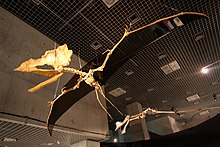Thalassodromeus
Thalassodromeus (ha̍k-miâ: Thalassodromeus; hàn-gú: 掠海翼龍屬) sī tsi̍t-tsióng tuā-hîng e Pterosaur, huà-tsio̍h teh Pa-se tang-pak-pōo huat-hēn.[1]
| Thalassodromeus Sî-kan hoān-ûi: Albian ~110 Ma | |
|---|---|

| |
| Reconstructed T. sethi skeleton (the postcranium is hypothetical) with Anhanguera behind, National Museum of Nature and Science, Tokyo | |
| Kho-ha̍k hun-lūi | |
| Kài: | Animalia |
| Mn̂g: | Chordata |
| Bo̍k: | †Pterosauria |
| A-bo̍k: | †Pterodactyloidea |
| Kho: | †Thalassodromidae |
| Sio̍k: | †Thalassodromeus Kellner & Campos, 2002 |
| Bô͘-sek chéng | |
| †Thalassodromeus sethi Kellner & Campos, 2002 | |
| Other species | |
| |
| Siâng-ì-miâ | |
| |
Hun-luī
siu-kái
Kun-ki Pinheiro kah i-ê tông-sū hun-luī ê Hun-chi tô͘, 2011:[2]
| Azhdarchoidea |
| |||||||||||||||||||||||||||||||||||||||||||||||||||||||||
Kun-ki Andres kah i-ê tông-sū hun-luī ê Hun-chi tô͘, 2014:[3]
| Neoazhdarchia |
| ||||||||||||||||||||||||||||||||||||||||||||||||
Tsù-kái
siu-kái- ↑ Kellner, A. W. A.; Campos, D. A. (2002). "The function of the cranial crest and jaws of a unique pterosaur from the early Cretaceous of Brazil". Science. 297 (5580): 389–392. Bibcode:2002Sci...297..389K. doi:10.1126/science.1073186. PMID 12130783. (Eng-gí)
- ↑ Pinheiro, F. L.; Fortier, D. C.; Schultz, C. L.; De Andrade, J. A. F.G.; Bantim, R. A. M. (2011). "New information on Tupandactylus imperator, with comments on the relationships of Tapejaridae (Pterosauria)" (PDF). Acta Palaeontologica Polonica. 56 (3): 567–580. doi:10.4202/app.2010.0057. (Eng-gí)
- ↑ Andres, B.; Clark, J.; Xu, X. (2014). "The Earliest Pterodactyloid and the Origin of the Group". Current Biology. 24 (9): 1011–1016. doi:10.1016/j.cub.2014.03.030. PMID 24768054. (Eng-gí)
Tsham-khó bûn-hèn
siu-kái- Witton, M. P. (2013). Pterosaurs: Natural History, Evolution, Anatomy (1st pán.). Princeton and Oxford: Princeton University Press. ISBN 978-0-691-15061-1. (Eng-gí)
Tsham-ua̍t
siu-kái- 2013 TV135
- siāng-sî-sìng guân-tsik (tông-sî-sìng guân-tsik / Simultanitätsprinzip / Koinzidenzprinzip)
- Hāu chhì-che (hāu shì-tse/Limulus amebocyte lysate (LAL))
- Bia̍t-im-khì (Be̽t-im-khì/Silencer (firearms))
- ST Kinetics
Guā-pōo lên-ket
siu-kái- The Pterosaurs That Weren’t] (Eng-gí)
- Feeding Habits Of Flying Reptiles Uncovered (Eng-gí)
- Thalassodromeus (Eng-gí)